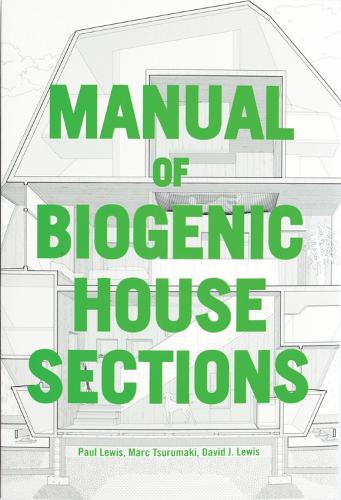
Manual of Biogenic House Sections
(Paperback)
Publishing Details
Manual of Biogenic House Sections
By (Author) Paul Lewis
By (author) Marc Tsurumaki
By (author) David J. Lewis
Oro Editions
Goff Books
20th June 2024
United States
Classifications
General
Non Fiction
Building construction and materials
Architecture: residential and domestic buildings
728.047
Physical Properties
Paperback
352
Width 190mm, Height 279mm
1330g
Description
Recognizing that buildings are a major contributor to global warming and the critical role of embodied versus operational carbon, the book focuses on houses built from materials that either sequester carbon (plants), use materials with very low embodied carbon (earth and stone) or reuse substantial amounts of existing materials.
Organized by those materials (wood, bamboo, straw, hemp, cork, earth, brick, stone and re-use), and incorporating life cycle diagrams demonstrating how the raw material is processed into building components, the book shows how the unique properties of each material can transform the ways architects conceive the sections of houses.
The house was selected as the vehicle for these investigations due to its scale, its role as a site of architectural experimentation, and its ubiquity. Building on the techniques of the Manual of Section, the book is comprised of newly generated cross-sectional drawings of fifty-five recent, modestly sized houses from around the world, making legible the tectonics and materials used in their construction. Each house is also shown through exploded axonometric, construction photographs and color photographs of the exterior and interior. Introductory essays set up the importance of embodied carbon, the role of vernacular plant-based construction and the problems of contemporary house construction. Drawing connections between the architecture of the house, environmental systems and material economies, the book seeks to change how we build now and for the future.
Reviews
"Published by ORO Editions, the book allows architects to rethink architectural cross-sections while using the raw materials of cross-sections that represent the lifeblood of buildings in their design." - World Architecture Community
Author Bio
Paul Lewis, FAIA is a Founding Principal of LTL Architects. He is professor of architecture at Princeton University School of Architecture. He is the president of the Architectural League of New York and a fellow of the American Academy in Rome. He received a Bachelor of Arts from Wesleyan University and a Master of Architecture from Princeton University. Marc Tsurumaki is a founding principal of LTL Architects. He is currently an adjunct associate professor of architecture at Columbia Universitys Graduate School of Architecture, Planning, and Preservation. He is the president of Storefront for Art and Architecture. He received a Bachelor of Science in Architecture from the University of Virginia and a Master of Architecture from Princeton University. David J. Lewis is a founding principal of LTL Architects. He is professor of architecture and Dean of Parsons School of Constructed Environments and is the recipient of the honorary position of adjunct professor of architecture at the University of Limerick, Ireland. He holds a Master of Architecture from Princeton University, a Master of Arts in the History of Architecture and Urbanism from Cornell University, and a Bachelor of Arts from Carleton College.
